Sure Do. Well, compared to Breitlings at least. I’ve heard some people say that Breitlings wear small for their case size because their bezels are smaller than the cases. But the Panerai Luminor with the Device Protecting the Crown definately has a bit more presence to it. I would say it wears somewhere between a Chronomat Evo or Steelfish and the big Breitling for Bentley Motors. It probably has a 45-46mm size presence for a 44mm watch.
Here are some pics of a couple of Panny’s with a couple of Breitlings so you can get an idea for yourself!

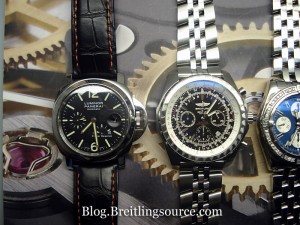
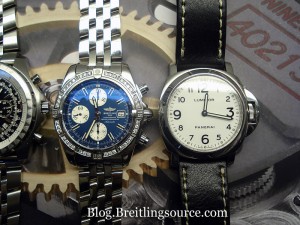
This is a companion article to my other polishing article that gives you a little bit of insight into restoring your brushed finish watches.
Finally, I’ve gotten around to taking pictures of some of my tools that I use to restore the final finish on my watches when they need some taking care of. It can be a bit of work getting a polish going nicely, and in addition to these tools, its nice to have a rubber vise, or a standard vise and some cloth to protect your watches and bracelets from getting damaged by the vise. Also always remember to wear eye protecting when you are working with power tools like a dremel.
The five different methods I’m going to discuss here are Fabulustre Cloth, Sunshine Cloth, Cape Cod Cloth, Metal Polish, the Dremel Polishing method. Each one varies in intensity, and you’ll want to pick the one that is most appropriate for your situation.
The Fabulustre Cloth

The Fabulustre cloth is without a doubt the most useful cloth that I have, and is fantastic for that final cleaning finish, and removes all the ‘residue’ from other polishing methods. I would say that this is a great cloth to have around even just to put your watch on when you are cleaning it with a different type of cloth. They are large and last a long time.
The Fabulustre cloth is really two clothes that are sewn together on one end. The red side is impregated with very very fine and weak abrasives that polish your watch or jewelry, and the yellow side is for buffing it afterwards. You simply rub anywhere where the watch is polished with the red side and then buff with the yellow. Very simple to use. Its great for weekly cleaning of your watch, but really doesn’t polish out any visible scratches.
Sunshine Cloths

The first time I ever heard of these clothes, they were hailed as the successor of the Cape Cod cloth, and that they were just as good but less messy. I was excited, and a very gracious member of the forum, Ianmedium, met with me at a local coffee shop and gave me two of them to try out. They are definately not a replacement for the cape cod, but they are defiantely a great way to maintain your watch in-between cape cod applications.
The sunshine cloth is kind of like a more effective fabulustre without the buffing cloth. It is a small single abrasive dry polishing cloth. It does leave a bit of residue on your hands when you are using it, but not nearly as much as a cape cod, which is moist. The Sunshine is a great way to maintain your watch if your feel like the fabulustre isn’t cutting it anymore. The Sunshine is also very easy to use. Just rub all over your polished watch with the sunshine cloth.
Cape Cod Cloths

The next step up from the Sunshine Cloth is the venerable Cape Cod cloth. It also is a polishing compound impregnated cloth, however the cape cod has a moist compound impregnanted which is more aggressive than that found in both the Fabulustre and the Sunshine cloths, with the added bonus (or not) of vanilla scent. The Cape Cods are a little bit more difficult to use because they are not dry, and require a buffing cloth to clean the vanilla scented polish off afterwards.
I have found the most effective way of using the cape cods is to rub with a cape cod in a circular motion for a fairly long time, say 20 seconds on each side of the bracelet. After the watch is lathered in the polish, take a clean dry microfiber cloth, and buff the bracelet until it is mostly clean, then rinse off the remaining polish in water.
Cape Cods leave your watch looking very shiny, with most of the minor swirlies gone. The biggest change is your watch will be totally shiny looking again. If you are not getting the results you want, the scratches may be too deep, or you might need to use more. If the scratches are any deeper, or you need to get into some areas where you need more precision, its probably better to use a metal polishing paste or use the polishing compound bars instead.
Metal Polishing Paste
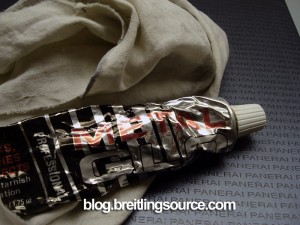
Polishing Pastes are a great way to maintain a polish on your watches when you need something a bit more agressive than a cape cod, but you do not have access to a dremel or aren’t really the handy type. Caution: Some polishes are not fine enough for a mirror polish and I have heard that they can leave fine scratches in your finish, which means you could use them as a secondary to a final polish with a stainless steel compound with dremel. One of the better polishing pastes I have found is Flitz. I could not find my flitz so I just have a photo of Metal Glo, which works well, but not quite as good.
Using a metal polishing paste is pretty easy. Just apply to a cottom or microfiber cloth and start polishing your watch in a circular motion. When you are satisfied, you can buff it off with a clean cotton or microfiber cloth. When you are done, just rinse in water to get the remaining polish out.
Dremel with Polishing Compound
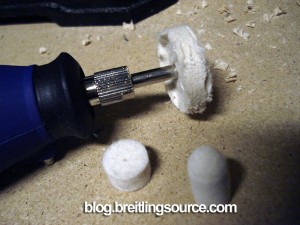
I find that any time I want a good final polish on a watch that need to be restored, there is no substitude for sticking the watch in a vise, and givin ‘er with the dremel. There’s my rotary tool with a standard buffing wheel and some felt pointed wheels and smaller wheels which are good for parts of the case that can be hard to get at. Its very important to use eye protection when using a dremel because it can launch things into your eye like metal particles and compound.
Its pretty easy to do if you have the right tools and a steady hand. Look the watch securly in your vise, and then turn your dremel on low speed, and load it up by placing it on the compound until the wheel is sufficiently loaded with compound. Once you’ve got it loaded you can start polishing your watch! When you switch from one compound to the next, be sure to use a different buffing wheel. Next I’ll explain which compounds I use for which tasks.
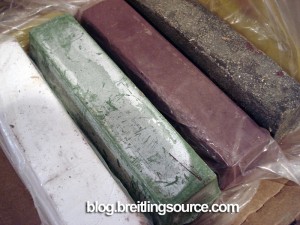
There’s a shot of four types of compound bars I have. You won’t be using the Brown Tripoli for stainless steel, but the Black Emery, White Rouge and Green Stainless compounds are all useful depending on the task at hand. I’m not going to talk about how to polish precious metal watches with your rotary tool because I’ve never done it before and I’m not familiar with the compounds. Precious metals like gold are much softer and you have to be extra careful when using power tools to polish them.
Black Emery is the most abrasive of the three and will usually only be used if there is a really deep scratch or pitting and you need to cut away a lot of material. It will leave the steel kind of shiny, but not quite factory shiny.
White Rouge cuts away a decent amount of material, but is less abrassive than the Black Emery. Good for light scratches that you can just feel with your fingernail.
Green Stainless is a final polish for stainless steel and is good for achieving that final brilliant glossy shine that Stainless has when it comes from the factory.
Remember to keep your buffing wheels loaded with compound, and remember not to overheat the metal. Metal gets hot when you polish it with power tools so be careful. Let it cool down after working at it for a while. Polishing watches is a simple thing to do when you have the right tools for the job. Hope you enjoyed the article, and happy polishing!
I picked up a new Macro Lens for my Sony Alpha camera the other day. I can now take 1:1 macro shots with this cool lens, which means I can see every little imperfection on watch dials and movements. I tooks some neat shots that I want to share with you guys.
Zenith Chronomaster Grande Date XXT Dial – I didn’t take this one too close but I did get a nice shot:

Panerai PAM114 Movement Jewel – Now that one is pretty close up. I doubt the fakes look that good up close:
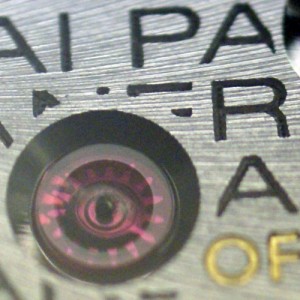
Zenith El Primero Movement up close and personal:

IWC Ingenieur dial shot:
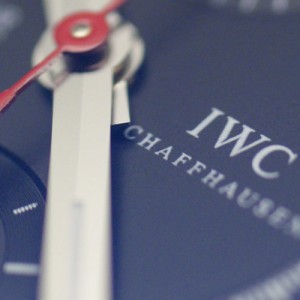
I really enjoy my new Macro lens, and I’ve been taking even more shots with it now. Its almost worth buying a dSLR camera just to be able to use one if you don’t already have one!
Being that I am also a custom handmade knife enthusiast, seeing Damascus used in a production watch was very interesting for me. I’ve seen Allen Elishewitz use Damascus on some of his custom watches, but I haven’t see it used on a production watch.
Angular Momentum is using it for the entire dial of their “Digital” watch. Don’t worry, it’s still an automatic mechanical movement. It just has a digital display, so to speak. You can see it here:

Now I’m a big fan of Damascus for knife blades, because it is a beatiful material, and the grain patterns that come from repeatedly hammering and folding over the different types of steel upon itself are stunning. However, I think this watch isn’t executed very well. The way the Damascus looks on the dial is kind of cheap.
There are many different types of damascus steel, and the one they chose for this application was not the prettiest, and I think they could have done better. However, it is an interesting start, and perhaps we will see more damascus and possibly mokume on watches in the future.
Diameter: 42mm
Water Resistant: 100m
Movement: Swiss Automatic 25 Jewel

















